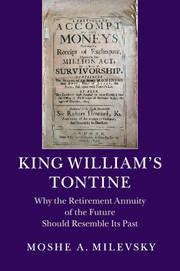Book contents
- Frontmatter
- Epigraph
- Contents
- Preface: In Memoriam for Jared
- Acknowledgments
- 1 King Billy, Protestant Hero of england
- 2 Tontine's Economic Origins: Cheaper Debt
- 3 A Most Curious Will(iam) and Older Than You Think
- 4 The Million Act to Fight a War against France
- 5 Don't Englishmen Die? Anti-Selection vs. Fraud
- 6 Is Your Tontine a Stock or a Bond?
- 7 Optimal Tontine: Hedging (Some) Longevity Risk
- 8 Conclusion: Tontines for the Twenty-First Century
- Epilogue: What Did William Really Know?
- Appendix A The List of Nominees
- Appendix B The Gompertz-Makeham Law of Mortality
- Appendix C 14% for One, 12% for Two, or 10% for Three?
- Source Notes and Guide to Further Reading
- References
- Index
7 - Optimal Tontine: Hedging (Some) Longevity Risk
Published online by Cambridge University Press: 05 May 2015
- Frontmatter
- Epigraph
- Contents
- Preface: In Memoriam for Jared
- Acknowledgments
- 1 King Billy, Protestant Hero of england
- 2 Tontine's Economic Origins: Cheaper Debt
- 3 A Most Curious Will(iam) and Older Than You Think
- 4 The Million Act to Fight a War against France
- 5 Don't Englishmen Die? Anti-Selection vs. Fraud
- 6 Is Your Tontine a Stock or a Bond?
- 7 Optimal Tontine: Hedging (Some) Longevity Risk
- 8 Conclusion: Tontines for the Twenty-First Century
- Epilogue: What Did William Really Know?
- Appendix A The List of Nominees
- Appendix B The Gompertz-Makeham Law of Mortality
- Appendix C 14% for One, 12% for Two, or 10% for Three?
- Source Notes and Guide to Further Reading
- References
- Index
Summary
A RATIONAL PROBLEM WITH TONTINE'S UTILITY
Up to this point in the narrative I haven't really opined about or addressed the issue of optimal tontine design versus suboptimal design from the perspective of economic theory. Sure, I have introduced the idea of “tontine thinking” and the sharing principle, including examples of many different tontine schemes. I have discussed their historical features, focused on their payout rates, and examined whether their yield was fair, relative to prevailing interest rates and competing products. I even touched on good tontines and bad tontines from a moral or ethical viewpoint. But thus far I have stayed clear of economic theory. In this chapter I will go one level deeper – which gets a bit more technical, as well – and address the economic properties of the scheme itself and some of the rational aspects of their design. I will introduce and discuss something called Jared's retirement tontine, which has some similarities to the historical design but differs in some important ways.
To put this all in perspective and set the context for this chapter, think about the following questions: How would the rational and logical Mr. Spock design a tontine scheme? And, how might it differ from the 300-year-old design of King William's tontine?
For starters, the single biggest problem with most historical tontine schemes – whether they are equity or debt or whether they are of Type 1, Type 2, or Type 3 – can be seen in the “winner take all” picture displayed in Figure 7.1. The graph displays the range of possible payouts to the tontine annuitant/nominee – assuming they are still alive – at ages ranging from 65 to 100. This example or picture assumes that a tontine scheme with 400 members is initiated at the age of sixty-five and the (constant) payout to the entire pool is a constant 4% per year.
- Type
- Chapter
- Information
- King William's TontineWhy the Retirement Annuity of the Future Should Resemble its Past, pp. 140 - 169Publisher: Cambridge University PressPrint publication year: 2015



